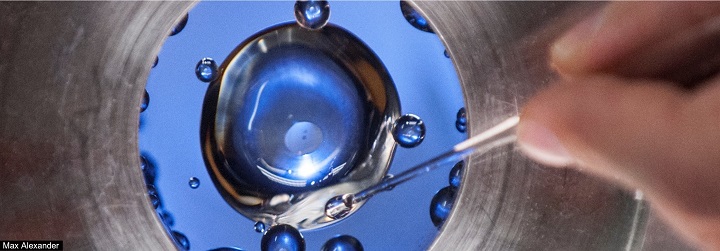Diamagnetic Levitation

Strong magnetic fields can levitate materials that we don’t ordinarily think of as ‘magnetic’ such as water, plastics and even biological organisms. The force of gravity is balanced throughout the levitating object by a force, the diamagnetic force, acting on each molecule, allowing us to perform experiments in conditions akin to weightlessness in the laboratory.
Diamagnetic materials are repelled by magnetic fields, but usually only very weakly --- your hand is repelled from, for example, a magnetic clasp on a mobile phone case --- but this force is so small that we don't notice it. By using the strong magnetic field generated by a superconducting magnet, up to 18.4 tesla, we can make this force large enough to levitate, for example, droplets of water into the air, as shown in the above photograph. In addition to mimicking weightlessness, the same diamagnetic forces can be used to imitate gravity on different planets, the Moon or Mars for example, or 'hypergravity' on an extra-solar world larger than the Earth.
Researchers
Richard Hill
Michael Swift
Matthew Scase
G. Hunter-Brown, N. Sampara, M. M. Scase, R. J. A. Hill, Appl. Phys. Lett. 122, 014103 (2023)
L.Liao and R. J. A. Hill. Phys. Rev. Lett. 119, 114501 (2017)
H. A. Pacheco-Martinez, L. Liao, R. J. A. Hill, M. R. Swift, R. M. Bowley, Phys. Rev. Lett. 110, 154501 (2013)
Research Areas
We use diamagnetic levitation and related techniques in a wide range of projects. Some examples are given below.
We welcome applications from prospective students interested in pursuing a PhD in the group. Please contact Dr Richard Hill in the first instance.
Equipment
The magnetic levitation laboratory houses two custom-built superconducting magnets:
- Cryogenic Ltd. 18.4 T superconducting magnet, room temperature 58mm diameter bore
- Oxford Instruments 16.5 T superconducting magnet, room temperature 50mm diameter bore
The design of these magnets allows convenient access to the high field-gradient region of the magnetic field, where magnetic levitation experiments are performed but could also be used for, e.g., I-V measurements on solid state samples using a suitable probe. The magnets can run at high field for extended periods (several days) allowing long duration experiments to be performed.
EMFL Dual Access
The facility is available to use as part of the European Magnetic Field Laboratory (EMFL) Dual Access Scheme.
We welcome proposals from potential users of the facility under this scheme. Please contact Dr Richard Hill in the first instance.